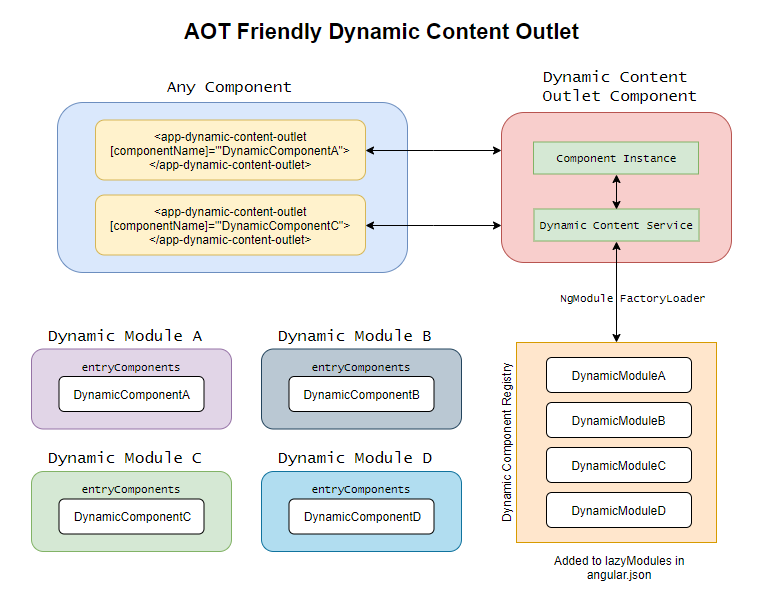Have you ever needed to dynamically load content or components in your Angular applications? How about in a way that the built-in structural directives (*ngIf*, *ngSwitch) just don’t provide? Are you also in need of the optimization benefits of using Ahead-of-Time compilation?
Well, I have good news for you…(And no you don’t have to be Chuck Norris!) If you stay tuned, I will help you get a solution up and running that will provide a solid way to choose from and load dynamically, at run-time, a set of predefined modules & components in your application.
This article is assumes you are building an Angular 6+ application generated using the Angular CLI. For information on using the Angular CLI check out the official documentation.
This arose out of a business need for the company that I work for. What’s important to note here is that many articles and examples exist on loading content dynamically in Angular, but none that I found worked reliably when compiling Angular with the
— prodor— aotflags enabled. The good news is that what I describe in this article works fantastically with Ahead-of-Time compiling.
We’re going to build a special module with a dynamic component outlet that can be included and used anywhere in your application. The only requirement is that you register, upfront, an array mapping your dynamic components to their parent modules. You will also add these modules to the lazyModules property in your angular.json file. By doing so, the compiler will pre-compile these modules. The compiler then splits them off into separate minified chunks and makes them available to the SystemJS loader at runtime, with AOT.
Assuming that you have an existing Angular 6+ CLI generated project let’s run through the following steps to scaffold the necessary parts that make up this new Dynamic Content Outlet.
Generate a new module named DynamicContentOutletModule by running the following command in your shell of choice:
$ ng g m dynamic-content-outletWe will come back later to this module and wire things up.
Create a new file underneath the newly created folder src/app/dynamic-content-outlet named dynamic-content-outlet.registry.ts. This will serve as the placeholder for array mapping component name to module path and module name. For now, it will be an empty array as follows.
interface RegistryItem {
componentName: string;
modulePath: string;
moduleName: string;
}
/**
* A registry array of Component Name to details
* that must be updated with each new component
* that you wish to load dynamically.
*/
export const DynamicContentOutletRegistry: RegistryItem[] = [];Create a new file underneath the folder src/app/dynamic-content-outlet/dynamic-content-outlet-error.component.ts. This will serve as the component to be rendered anytime an error occurs attempting to load a dynamic component. You can customize the template property to use any custom styles or layout that you may have. The errorMessage input must stay the same and will be fed with the actual details of the error that occurred while attempting to dynamically render your component.
import { Component, Input } from '@angular/core';
@Component({
selector: 'app-dynamic-content-outlet-error-component',
template: `
<div>{{ errorMessage }}</div>
`
})
export class DynamicContentOutletErrorComponent {
@Input() errorMessage: string;
constructor() {}
}Create a new file underneath the folder src/app/dynamic-content-outlet/dynamic-content-outlet.service.ts.
- This service encapsulates the logic that loads dynamic components using SystemJS and renders them into the Dynamic Content Outlet.
- It uses the
DynamicContentOutletRegistryto lookup the module bycomponentName. - It also makes use of a new
staticproperty that we will add later on to each module we wish to dynamically load nameddynamicComponentsMap. This allows us to get the type literal for the givencomponentNameso that theresolveComponentFactorycan instantiate the correct component. You might ask why we didn't just add a fourth property to theDynamicContentOutletRegistry, well this is because if we import the type in the registry, then it defeats the purpose of lazy loading these modules as the the type will be included in the main bundle. - If an error occurs, a
DynamicContentOutletErrorComponentis rendered instead with the error message included.
import {
ComponentFactoryResolver,
ComponentRef,
Injectable,
Injector,
NgModuleFactoryLoader,
Type
} from '@angular/core';
import { DynamicContentOutletErrorComponent } from './dynamic-content-outlet-error.component';
import { DynamicContentOutletRegistry } from './dynamic-content-outlet.registry';
type ModuleWithDynamicComponents = Type<any> & {
dynamicComponentsMap: {};
};
@Injectable()
export class DynamicContentOutletService {
constructor(
private componentFactoryResolver: ComponentFactoryResolver,
private moduleLoader: NgModuleFactoryLoader,
private injector: Injector
) {}
async GetComponent(componentName: string): Promise<ComponentRef<any>> {
const modulePath = this.getModulePathForComponent(componentName);
if (!modulePath) {
return this.getDynamicContentErrorComponent(
`Unable to derive modulePath from component: ${componentName} in dynamic-content.registry.ts`
);
}
try {
const moduleFactory = await this.moduleLoader.load(modulePath);
const moduleReference = moduleFactory.create(this.injector);
const componentResolver = moduleReference.componentFactoryResolver;
const componentType = (moduleFactory.moduleType as ModuleWithDynamicComponents)
.dynamicComponentsMap[componentName];
const componentFactory = componentResolver.resolveComponentFactory(
componentType
);
return componentFactory.create(this.injector);
} catch (error) {
console.error(error.message);
return this.getDynamicContentErrorComponent(
`Unable to load module ${modulePath}.
Looked up using component: ${componentName}. Error Details: ${
error.message
}`
);
}
}
private getModulePathForComponent(componentName: string) {
const registryItem = DynamicContentOutletRegistry.find(
i => i.componentName === componentName
);
if (registryItem && registryItem.modulePath) {
// imported modules must be in the format 'path#moduleName'
return `${registryItem.modulePath}#${registryItem.moduleName}`;
}
return null;
}
private getDynamicContentErrorComponent(errorMessage: string) {
const factory = this.componentFactoryResolver.resolveComponentFactory(
DynamicContentOutletErrorComponent
);
const componentRef = factory.create(this.injector);
const instance = <any>componentRef.instance;
instance.errorMessage = errorMessage;
return componentRef;
}
}Create a new file underneath the folder src/app/dynamic-content-outlet/dynamic-content-outlet.component.ts. This component takes an input property named componentName that will call the DynamicContentOutletService.GetComponent method passing into it componentName. The service then returns an instance of that rendered and compiled component for injection into the view. The service returns an error component instance if the rendering fails for some reason. The component listens for changes via the ngOnChanges life-cycle method. If the @Input() componentName: string; is set or changes it automatically re-renders the component as necessary. It also properly handles destroying the component with the ngOnDestroy life-cycle method.
import {
Component,
ComponentRef,
Input,
OnChanges,
OnDestroy,
ViewChild,
ViewContainerRef
} from '@angular/core';
import { DynamicContentOutletService } from './dynamic-content-outlet.service';
@Component({
selector: 'app-dynamic-content-outlet',
template: `
<ng-container ##container></ng-container>
`
})
export class DynamicContentOutletComponent implements OnDestroy, OnChanges {
@ViewChild('container', { read: ViewContainerRef })
container: ViewContainerRef;
@Input() componentName: string;
private component: ComponentRef<{}>;
constructor(private dynamicContentService: DynamicContentOutletService) {}
async ngOnChanges() {
await this.renderComponent();
}
ngOnDestroy() {
this.destroyComponent();
}
private async renderComponent() {
this.destroyComponent();
this.component = await this.dynamicContentService.GetComponent(
this.componentName
);
this.container.insert(this.component.hostView);
}
private destroyComponent() {
if (this.component) {
this.component.destroy();
this.component = null;
}
}
}Make sure your src/app/dynamic-content-outlet/dynamic-content-outlet.module.ts file looks like the following:
import { CommonModule } from '@angular/common';
import {
NgModule,
NgModuleFactoryLoader,
SystemJsNgModuleLoader
} from '@angular/core';
import { DynamicContentOutletErrorComponent } from './dynamic-content-outlet-error.component';
import { DynamicContentOutletComponent } from './dynamic-content-outlet.component';
import { DynamicContentOutletService } from './dynamic-content-outlet.service';
@NgModule({
imports: [CommonModule],
declarations: [
DynamicContentOutletComponent,
DynamicContentOutletErrorComponent
],
exports: [DynamicContentOutletComponent],
providers: [
{
provide: NgModuleFactoryLoader,
useClass: SystemJsNgModuleLoader
},
DynamicContentOutletService
]
})
export class DynamicContentOutletModule {}Phew! Take a deep breath and grab a cup of coffee (french press fair trade organic dark roast). The hard work is behind you. Next we will go through the process of actually putting this new module into play!
For any component that you would like dynamically rendered you need to do the following four steps. These steps must be followed exactly.
-
Confirm that the component is listed in the
entryComponentsarray in the module that the component is a part of. -
Add to the module, a new
staticproperty calleddynamicComponentsMap. This allows us to get the type literal for the givencomponentNameso that theresolveComponentFactorycan instantiate the correct component.
You might ask why we didn't just add a fourth property to the
DynamicContentOutletRegistrynamedcomponentType; well this is because if we import the type in the registry, then it defeats the purpose of lazy loading these modules as the the type will be included in the main bundle.
A prepared module might look as follows:
import { CommonModule } from '@angular/common';
import { NgModule } from '@angular/core';
import { DynamicMultipleOneComponent } from './dynamic-multiple-one.component';
import { DynamicMultipleTwoComponent } from './dynamic-multiple-two.component';
@NgModule({
declarations: [MySpecialDynamicContentComponent],
imports: [CommonModule],
entryComponents: [MySpecialDynamicContentComponent]
})
export class MySpecialDynamicContentModule {
static dynamicComponentsMap = {
MySpecialDynamicContentComponent
};
}For any component that you would like dynamically rendered, add a new entry to the DynamicContentOutletRegistry array in src/app/dynamic-content-outlet/dynamic-content-outlet.registry.ts.
The following properties must be filled out:
-
componentName: This should match exactly the name of the Component you wish to load dynamically. -
modulePath: The absolute path to the module containing the component you wish to load dynamically. This is only the path to the module and does NOT includemoduleNameafter a#. -
moduleName: This is the exact name of the module.
{
componentName: 'MySpecialDynamicContentComponent',
modulePath: 'src/app/my-special-dynamic-content/my-special-dynamic-content.module',
moduleName: 'MySpecialDynamicContentModule'
},In your angular.json update the projects > ** > architect > build > options > lazyModules array and add an item for each module that you added to the registry in order for the Angular AOT compiler to detect and pre-compile your dynamic modules. If you have multiple projects in a folder, make sure you add this for the correct project you are importing and using dynamic modules in. The updated file will look similar to this:
{
...
"projects": {
"angular-dynamic-content": {
...
"architect": {
"build": {
"builder": "@angular-devkit/build-angular:browser",
"options": {
...
"lazyModules": ["src/app/my-special-dynamic-content/my-special-dynamic-content.module"]
},
}
}
}
}
}Up to this point you have created your dynamic content outlet module and registered your components to be available in the outlet. The last thing we need to do is wire up our new DynamicContentOutletModule to be used in our application. In order to do so you need to:
- Add your new
DynamicContentOutletModuleto theimportsarray of any feature module or the mainAppModuleof your Angular application.
@NgModule({
...
imports: [
...
DynamicContentOutletModule
],
...
})
export class AppModule {}- Add the following tag to the template of the parent component that you would like to render the dynamic content in:
<app-dynamic-content-outlet [componentName]="'MyComponent'">
</app-dynamic-content-outlet>This is very similar in nature to Angular’s built-in <router-outlet>/</router-outlet> tag.
- Happy
ng serve --proding!
If you are interested in a more in-depth real-world example, then check out the Github Repository which will demonstrate the following:
- Dynamic modules with multiple components
- Demonstrating the use of on-the-fly component changes
- Demonstrating that the scoped styles are loaded dynamically for each component
GitHub Repository Example https://github.com/wesleygrimes/angular-dynamic-content
Hopefully you have found this solution helpful. Here is the full GitHub repository example for you to clone and play around with. PR’s are welcome, appreciated, encouraged and accepted!
I would highly recommend enrolling in the Ultimate Angular courses. It is well worth the money and I have used it as a training tool for new Angular developers. Follow the link below to signup.
Ultimate Courses: Expert online courses in JavaScript, Angular, NGRX and TypeScript
I want to take a moment and thank all those I was able to glean this information from. I did not come up with all this on my own, but I was able to get a working solution by combining parts from each of these articles!
-
Here is what you need to know about dynamic components in Angular
-
The Need for Speed Lazy Load Non-Routable Modules in Angular
-
Also, a huge thank you to Medium reader ivanwonder and Github user Milan Saraiya for pointing this out and providing a fork example of resolution.


